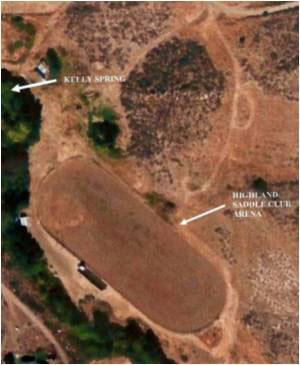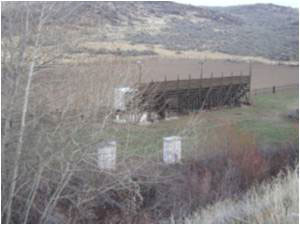

“Cowiche Valley From Top Of Cowiche Mountain Looking North”
Kelly Spring
Some of the Cowiche Calls website content was maliciously attacked. Please check back periodically as we continue to recover content.
When settlers began to settle the Cowiche the primary objective was to find land with water on it or, at the very least, land with water near-by. Other than the rivers and creeks, the only sources of water were natural springs and rainfall. It rains less than eight inches annually in the Cowiche making dependency on rainfall for most crops and livestock fool hearty.
Settlers first homesteaded the valley along the main stream of the Cowiche and its South Fork. There were also some early settlers along the Lower North Fork for a mile or so upstream of its mouth because the ground water was close to the surface and shallow wells could be dug. However, the North Fork channel in the early days would be dry beginning in late July and would not have water flowing again for several months. Some settlers dug wells, but the wells also dried up during the hot, dry, summer months.

The only year round sources of water in the North Fork Valley in the early days was “Horse Camp Spring” in French Canyon, which was later renamed “Koempel Spring” and “Kelly Spring” named after Philander Kelly. Kelly Spring is approximately a half mile south east of Tieton City of today just north of the North Fork channel, as shown on the map above. After Kelly’s death the Donnelly family purchased the land where the spring is located and it became known as “Donnelly Spring.”
Philander Kelly (often found spelled Kelley) was believed to be the first homesteader in the vicinity of present day Tieton City. Old Joe Robbins, a squawman turned farmer also homesteaded along the North Fork about a mile down stream from Kelly. Joe Robbins was probably Kelly’s closest neighbor in 1880. Robbins had likely been in the area many years earlier trapping for Alexander Ross and The Northwest Company and returned to settle in the area once the beaver ran out.
Eventually Joe Robbins, known to the Yakama as a squawman because of his Indian wife, moved with his wife and nine children to the Yakama Indian Reservation to live out their lives. Most mountain-men or trappers traded horses with the Yakama for one or two young Shoshoni slave women or other Indian females to help with camp chores. Eventually many became common-law wives of the mountain-men and bore them many children.
Kelly had been but a boy when his family came from Oregon Territory to homestead in the 1870s in the area we think of today as Lower Naches. After arriving, Philander’s father died of pneumonia and his older brother drowned taking a team and wagon across the Naches River some time in the mid to late 1870s. Philander ran the ranch for his mother and sister who remained, but worked part-time for A. J. Splawn and others. As he grew of age, he homesteaded the 160 acres along the North Fork that originally became known as the Kelly Place or Kelly Spring.
It is believed Philander filed for his homestead in 1880. His heirs were granted the homestead patent in 1885 following Kelly’s death in January 1881. (See the stories about the “Cowichee Natchez Cemetery” on this website or in the book entitled “Cowiche Calls.”) Kelly froze to death searching for horses in the winter of 1881 on Loudon Hill near French Canyon and was the first buried in the old Cowichee-Natchez Cemetery (Cowiche-Naches Cemetery) in March 1881.
 Kelly Spring was the site of the second school in the region. The first school was constructed in the summer of 1873 and the first classes were held that fall once the crops were harvested. The first school was located where the Cowiche Grange Hall was located in the mid to late twentieth century near the intersection of Cowiche Mill Road and Summitview Road. By the school year 1882 enough families had settled the North Fork Valley and also in the dry-lands making the original school no longer centrally located and convenient for many of the settler’s families.
Kelly Spring was the site of the second school in the region. The first school was constructed in the summer of 1873 and the first classes were held that fall once the crops were harvested. The first school was located where the Cowiche Grange Hall was located in the mid to late twentieth century near the intersection of Cowiche Mill Road and Summitview Road. By the school year 1882 enough families had settled the North Fork Valley and also in the dry-lands making the original school no longer centrally located and convenient for many of the settler’s families.
 Issac Hayes (Great Grandfather of Steve VanderHouwen, see the story of Steve VanderHouwen elsewhere on this website.) lead a group who petitioned the School Board to move the original school building to a more centralized location. The School Board refused which enraged Hayes even though he had homesteaded down on the Naches River far from the proposed new location to which the petition called for the school to be moved. Hayes immediately petitioned the territorial county to have the area he lived in separated from the Cowiche School District and to have the remaining portion of the Cowiche School District split to form a new district in the North. The new district to be called the North Cowiche School District roughly covered the area north of Wilcox Road, Forney Lane and Hiland Road of today.
Issac Hayes (Great Grandfather of Steve VanderHouwen, see the story of Steve VanderHouwen elsewhere on this website.) lead a group who petitioned the School Board to move the original school building to a more centralized location. The School Board refused which enraged Hayes even though he had homesteaded down on the Naches River far from the proposed new location to which the petition called for the school to be moved. Hayes immediately petitioned the territorial county to have the area he lived in separated from the Cowiche School District and to have the remaining portion of the Cowiche School District split to form a new district in the North. The new district to be called the North Cowiche School District roughly covered the area north of Wilcox Road, Forney Lane and Hiland Road of today.
Time did not permit the construction of a new school building by August 1882, when Hayes was granted his new North Cowiche School District. So a structure near the sight of Kelly Spring was chosen for the new school building. The building selected was poorly constructed and in fact probably was a revamped farm building. The building used for the school may well have been the log cabin Philander Kelly had constructed for himself a year or so earlier. The school called “North Fork School,” at Kelly Spring thus began in the fall of 1882 with Miss Fanny Strang, its first teacher. In that first year and subsequent years the enrollment often was fewer than ten students at any one time. Like most of the early schools it operated only two or three months out of the year.
More and more families settled along the North Fork and in the North Fork dry-lands between 1882 and 1885 causing a demand by the new residents that the North Fork School itself be moved to a more centralized location. Again there was a dispute, many wanting the school left at Kelly Spring because of the proximity to their farms. However, a vote was taken and the proponents of moving the school won the vote.
The vote to move the school outraged a group of the minority voters. On the night before the building was scheduled to be moved it burned to the ground! One can only speculate as to the accidental nature of the burning of the “North Fork School.” From 1885 to 1895 there was no official school building in the North Cowiche School District and school was held at the homes or in buildings owned by local residents including the homes of P. J. Beffa and Pat Donnelly.
The site of Kelly/Donnelly Spring continued on as a prominent local meeting place (watering hole) over the years, as farmers in the dry-lands would bring there livestock to the spring for water during the dry summer months when their other sources of water dried up. Residents used Koempel Spring, Donnelly (formerly Kelly) Spring, and a well Thomas O. Weddle had dug on his homestead in about 1887. The two springs and Weddle’s Well were the only sources of fresh water along the North Fork during the drought months of summer until Tieton Irrigation water began to flow in 1910.
Weddle had homesteaded what is today the city of Tieton and the well he dug was used by dry-land farmers during summer droughts, just as they used Koempel and Donnelly Springs. The well Tom Weddle dug was also the source of water for the small town of Tieton initially in 1909. The well, now called Van Epp’s Well, is located in the backyard of 513 Newland Pl., in Tieton. The well and creek that once flowed near-by have both long been filled in.
Kelly Spring and Koempel Spring, and even Tom Weddle’s Well, was essential to survival in the dry-lands of the North Fork region. It was not uncommon to see family members on horse back or on foot driving livestock to Kelly Spring in early morning or late afternoon in July, August and September for water.